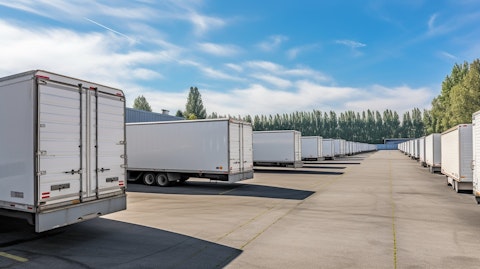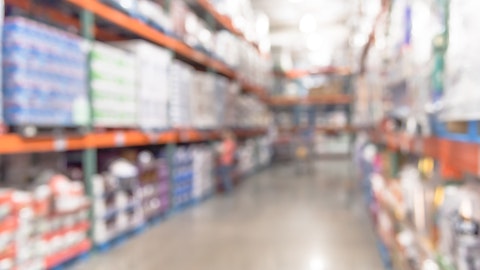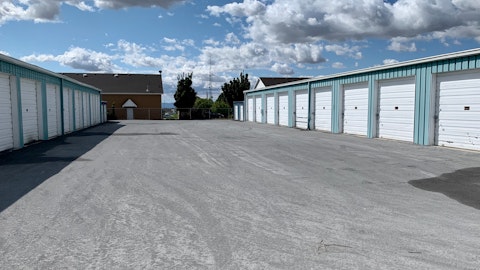U-Haul Holding Company (NYSE:UHAL) Q2 2024 Earnings Call Transcript November 9, 2023
Operator: Good morning. My name is Cynthia and I will be your conference operator today. At this time, I would like to welcome everyone to the U-Haul Holding Company Second Quarter Fiscal 2024 Investor Conference Call. All lines have been placed on mute to prevent any background noise. After the speaker’s remarks, there will be a question and answer session. [Operator Instructions] Thank you. Sebastian Reyes, you may begin your conference.
Sebastien Reyes: Good morning. And thank you for joining us today. Welcome to the U-Haul Holding Company’ second quarter of fiscal 2024 investor call. Before we begin, I’d like to remind everyone that certain of the statements during this call including without statements, including without limitation statements regarding revenue, expenses, and income in general growth of our business may constitute forward-looking statements within the meaning of the Safe Harbor provisions of Section 27A of the Securities Act of 1933, as amended, and section 21E of the Securities Exchange Act of 1934 as amended. Forward-looking statements are inherently subject to risk and uncertainties, some of which cannot be predicted or quantified. Certain factors could cause actual results to differ materially from those projected for discussion of the risks and uncertainties that may affect the company’s business, and future operating results, please refer to the company’s public SEC filings and Form 10-Q for the quarter ended September 30, 2023, which is on file with the U.S. Securities and Exchange Commission.
I’ll now turn the call over to Joe Shoen, Chairman of U-Haul Holding Company.
Joe Shoen: Thanks, Sebastian. And thank you everybody for joining us again. As I’m sure you see from the numbers we’ve given back more of the U-move pandemic transaction gains, that I would like. The Safemove transaction decline impacts most of our product lines. All of our business lines remain competitive. However, I’m not cutting back on rental fleet CapEx due to being starved for new equipment in the 2020 to 2022 timeframe. Rental equipment acquisition and maintenance costs, unfortunately continue to outpace inflation. Disruption of the OE supply chain due to government mandates for electrification are a huge driver of these increased costs. The public is starting to push back on electric vehicle mandates that fail to meet nearly every metric of a sustainable vehicle strategy.
And this may cause some pause with the OEs. U-Haul is continuing to invest in self-storage and U-Box product, with the expectation of revenue over the next five years. Our typical project is about three years from acquisition to opening. Shutting down development now will cause a revenue low two to three years from now. This strategy clearly is causing increased carrying costs. We are also investing heavily in digital tools to enhance the customer experience. I consider this vital to our continued success. My focus remains on continued implementation of the fundamentals in our U-move and U-store businesses. I will now turn the call over to Jason for a run through the numbers.
Jason Berg: Thanks, Joe. Good morning, everyone. Yesterday we reported second quarter earnings of $2.74 or $234 million, compared to $350 million for the same quarter last year. From an earnings per share perspective, we reported $1.40 for non-voting share this quarter, as compared to $1.73 for non-voting share in the second quarter of last year. This brings our reported six month earnings to $530 million, compared to $688 million for the same period last year. We reported $2.71 per non-voting share for the six months compared to $3.41 per non-voting share last year. Starting off with equipment rental revenue results, compared to the second quarter of last year, we had a $93 million decrease or about 8%. Over the last five quarters now we’ve had a $320 million decrease in U-move revenue.

Once again remind everyone, of the eight quarters that we had before that starting with our second quarter of fiscal 2021 where we experienced a $1,428 million increase over that timeframe. Compared to our last pre-pandemic second quarter, which ended on September 30 2019, we’ve increased our second quarter equipment rental revenue results by over $265 million on a compounded growth basis, that’s about 7.5% annual rate. All of this to say that while we’re giving back some of the pandemic era gains were far from losing all of that. The trends that we’ve seen the past several quarters continued. Total transactions declined a little over 4%. Miles per transaction fell compared to last year, although we’re still ahead of pre pandemic numbers. And revenue per mile has continued to incrementally improve, albeit at a slower rate than what we’ve seen in the last couple of years.
October results continued to trend downward compared to last year. Capital expenditures for new rental equipment for the first 6 months were $974 million. That’s a $256 million increase compared to the same time last year. We’ve increased our fiscal 2024 full year net CapEx projection, so that’s net of sales, from $820 million to approximately $870 million. Proceeds from the sales of retired rental equipment increased by about $80 million to a total of $405 million for the 6 months. Sales volume has increased, while average proceeds per unit sold has declined. Switching to Self-Storage. Revenues were up $23 million. That’s about a 13% increase for the quarter. The improvement was split between increases in the total number of occupied rooms, combined with higher revenue per occupied square foot.
Our occupied unit count at the end of September was up over 35,000 compared to the same time last year. During that same time frame, we added nearly 53,000 new units to the portfolio. It’s this differential that’s leading to our all-in average occupancy rate during the quarter decline by 120 basis points to 84.2%. This same moderation in occupancy can also be seen in, what we’re referring to as, our same-store grouping in our press release where we had an occupancy decrease of about 170 basis points to 95%. From what I can read and hear other public firms in the self-storage space have been reporting a toughening market brought on by changing consumer behavior and perhaps rate actions that have been taken over the last couple of years. I can tell you that we are experiencing a slowdown in move-in activity as well compared to the last couple of years.
However, our asking rents for new customers on average across the entire portfolio are up a little over 3% year-over-year. Another metric to consider is our average new customer rents compared to the rents that are paid by people who are leaving. The incoming rates were a little over 1% higher than the rents paid by customers who have been leaving. It’s very likely that the downward pressure on new move-ins and the reported discounting by some of our competitors could slow our Self-Storage growth the rest of this year. During the first 6 months of fiscal 2024, we invested $633 million in real estate acquisitions. That’s along with Self-Storage and U-Box warehouse development. That’s a $49 million increase over the first 6 months of last year.
Most all of that is in the form of additional development costs. During the quarter, we added 872,000 new net rentable square feet, about 400,000 of that was the acquisition of existing Self-Storage. And we currently have a little bit north of 7,400,000 new net rentable square feet being actively worked on. Our operating earnings in our Moving and Storage segment decreased by $113 million to $402 million for the quarter, brought down by the slowing of U-Move revenue. Operating expenses were up $24 million for the second quarter. Fleet repair and maintenance was up $17 million. That’s a combination of costs associated with us prepping trucks for sale, along with costs associated with preventative maintenance work. Personnel costs were up $18 million.
Our headcount for this quarter compared to the same quarter last year was up about 2.5%, which is significantly down from the increase we saw last year at this time of around 16%. As a percent of revenue, this quarter was higher than what we reported in the last 2 fiscal second quarters. However, if you go back in time, personnel costs right now are not out of line in comparison to similar time periods in previous years. We’re continuing to place a premium on having access to cash and liquidity. At the end of September of this year, cash along with availability from existing loan facilities at our Moving and Storage segment totaled $2.555 billion. With that, I would like to hand the call back to our operator, Sindhu, to begin the question-and-answer portion of the call.
Operator: [Operator Instructions] Our first question comes from Steven Ralston from Zacks. Please go ahead, your line is open.
See also Top 20 Gold Mining Companies in the World and Top 20 Diamond Producing Countries in the World.
Q&A Session
Follow U-Haul Holding Co (NASDAQ:UHAL,UHALB)
Follow U-Haul Holding Co (NASDAQ:UHAL,UHALB)
Steven Ralston: Good morning. Going through the numbers, it appears, at least to me, that the operations are being affected by the slowdown in moving activity. But it seems to be just like a step down to a lower plateau from your record year. I mean, I’ve gone through a lot of these segments. I’ve got a model that incorporates seasonality. And even in the Self-Storage business, it just seems to be step down to a slightly lower level, mid-single-digit level — a lower level. First of all, would you agree with that?
Joe Shoen: This is Joe. I would agree. I’m not accepting that. I’m looking for something different, but I think that is a number for sure.
Steven Ralston: Given that premise, at least from my point of view, the only aberration I see is that the cost of the self-moving equipment have increased more than expected. And also these products increased somewhat also. In — I guess, about 2 conference calls ago, you had plans to deal with this increased cost, primarily due to inflation. Could you expand on how that’s progressing?
Joe Shoen: So I’m not sure what you meant by other products, but I’ll address…
Steven Ralston: New self-moving products and services.
Joe Shoen: Okay. I think that any pressure there is give or take, inflationary, it’s not out of control. When you get into our motor vehicle fleet, there’s where you see what you read about in the newspaper, which is basically the — due to government mandates, all suppliers are subsidizing electric vehicles by enormous increases in gross margin on their internal combustion fleet. We’re stuck in that little bind right now. Buying electric vehicles isn’t the way out because they don’t really have product. I don’t — I don’t have any effective way to lobby the manufacturer to change course there. As you know, they have tremendous political pressure on them. So what’s really going to have to modulate this in my judgment is sales at the dealerships.
The point they can unload this stuff with the dealerships, they’re going to have to face the music. The retail customer does not have to buy the vehicle this year. We’re running a business. We kind of need to replenish stocks, but the retail customer can put a vehicle purchase off. And I think that until that happens, we’re not going to see any change in the manufacturer strategy, which is basically to subsidize their enormous losses on electric vehicles by charging people who drive a gasoline powered vehicle. What can we do given that we can’t influence that at least in the short term? We have to work on productivity of rental equipment, which is largely positioning. Now us having 32,000-plus retail outlets is a wonderful competitive tool, but it’s a very — goes just the other way on productivity of equipment to more outlets you have, the harder it is to maintain levels of productivity.
Over the years, we’ve been able to deal with this with improved electronic tools and more or less knowing where our equipment is on a real-time basis. There’s still some gains to be made there. And so I’m focused on that real hard. We’re investing real steadily in improved digital experience, the customer. Our customer just like pretty much everybody in the economy, a big percentage of our customer wants to have a digital experience, not a person-to-person experience. So we’re investing to improve that experience. Those gains are slow, but we’re — we see as we’re making some gains there, and we get the customer a little happier. So the position of the equipment is a big focus of mine at this time because that’s something we kind of control.
We don’t totally control it because customers go where they want to go. But we have ways to influence that. And that’s been my focus. I had all my direct field reports in about a month ago, we went through some ABCs of how we’re going to better position this equipment. That takes a little while, you can’t just move them. But we’ll make some progress on that and maybe dent these increasing costs a little bit. But right now, I don’t see how we’re going to get ahead of them in the near term.
Steven Ralston: Initially, you did not accept my premise that we just stepped down to a slightly lower plateau in the basic self-moving business. What is your view?
Joe Shoen: Well, I thought I said that, yes, we’re now as what Jason calls, at more historical growth levels. And you’re calling that a plateau, okay, I hear the same thing. And there’s no question that’s it. But of course, over my career, that’s just not my — I think that’s what I’m accepting will then what you want to call, you’ll be finishing in the middle of the pack. I don’t expect that. I expect us to go ahead. I think there’s always room in the capitalistic economy for someone who will hustle everybody else. And then eventually, if you work on a problem long enough, you’ll gain some advantage. But I don’t — other than digital tools, which I’m sure everybody you follow is working on. Other than that, I don’t have an advanced staring me straight in the face, okay.
But we’ve gone to sell dispatch on rental equipment to a great extent. We’ve gone to self-move-in to self-storage to a great extent. Those you can’t pull it from the numbers, but that’s baked into the numbers. And that’s not been enough to turn the thing. So you can say we’re right back where we started, although we’re well ahead of where we projected this out 5 years ago, we did project we’d be anywhere near this good on revenue. So all my life, we’ve been able to increase transactions at greater than the rate of population growth. You can argue that moving is a need, not a want. People do it because of fundamental things like births and deaths. And so then you could say, well, we should be performing at the rate of the population growth. Well, I’ve never accepted that.
And in fact, we have never performed at that lower level. And so what is it finding more customer needs, so we can satisfy with our self-move or our self-storage product. We continue to push hard on the U-Box product. And the U-Box product is — resonates with a significant number of customers. And I have an effort right now to make our digital tools much more customer friendly. Our transactions are still too awkward there in my — or to complicated, I guess, the way to say it. And we’re trying to get that simplified to where it’s an easier thing for the customer to execute.
Operator: Our next question comes from Keegan Carl from Wolfe Research. Please go ahead, your line is open.
Keegan Carl : Yes, thanks for the time guys. I guess maybe first, just trying to better understand what some of the moving parts in the moving business. So I understand it’s down 8% year-over-year, but obviously, you’ve grown your store count and footprint, too. So I’m just curious how much of your store count grow in the same period year-over-year? And I know Jason mentioned transaction is down 4%. I’m assuming it’s not on a comparable basis. I’m just trying to better understand because I’m actually a bit surprised how well it’s held in given what’s going on with the existing home sales on a year-over-year basis.
Jason Berg: Keegan, this is Jason. I’ll start with the distribution footprint. We’re about the same number of retail locations that we were last year at this time, like within 30. We’re at about 23,730 at the end of September. We did manage to grow the company-operated locations by about 66 from last year at this time to this point.
Joe Shoen: I’ll pipe in on that. I usually kind of company location is 10 independent locations. When I try to say where am I moving, which is kind of what your question is. So you could argue that if we’re up 60 locations, I’d say we’re really probably up 650 or something like that. Net effect on the consumer, which is disappointing because I’d like to have seen more transactions. Of course, some of the parties hardly — a lot of these things we kind of learn as we go, but I think we’re going to continue to see transaction growth. We have stabilized a little bit in what we call in-town transactions, which is the rent it here, return it here. And those are more — it’s like controllable. I don’t know the right number, but it’s — word for it, but it’s easier to work that number kind of than it is the one-way transaction.



